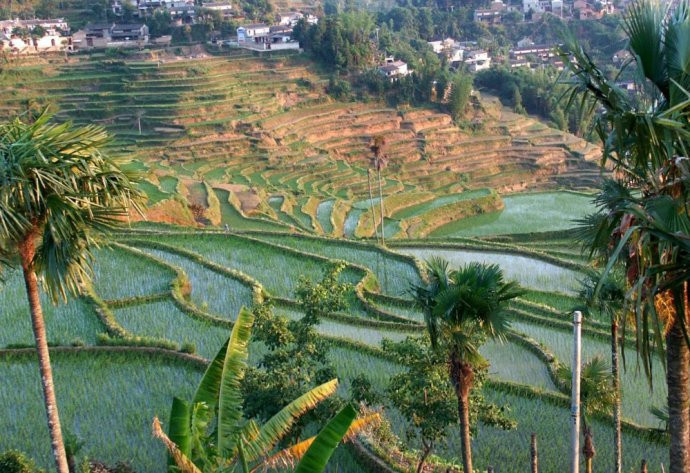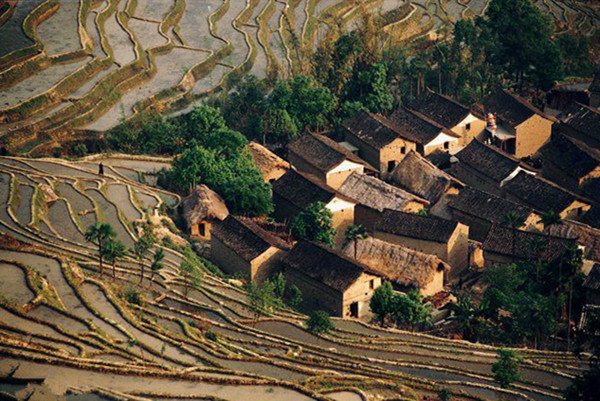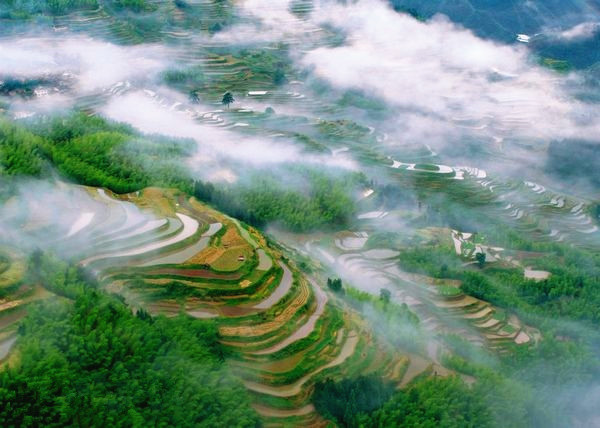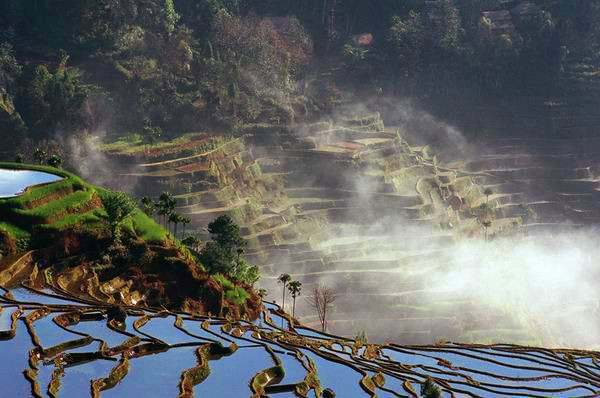Hani Ethnic Villages of Dayangjie in Honghe County, Honghe
Overview
The Hani Ethnic Villages (哈尼族民俗村, Hāní zú mínsú cūn) are situated on the hillside of Dayangjie Township (大羊街乡, Dà yáng jiē xiāng) in Honghe County (红河哈尼族彝族自治州, Hónghé Hānízú Yízú Zìzhìzhōu), Yunnan Province (云南省, Yúnnán shěng). This picturesque area spans approximately 5 hectares and is home to about 150 households and over 800 residents. The dense forests, accompanied by the sounds of chirping birds and buzzing cicadas, create a vibrant and original rural atmosphere that is both tranquil and inviting.
This folk village embodies the shared cultural essence of Hani rice terrace culture, characterized by the unique interconnection of forests, villages, rice terraces, and rivers. It has earned the title of the Hani Ethnic Four-Dimensional Exhibition Area (哈尼族四度同构展示区, Hāní zú sìdù tónggòu zhǎnshìqū), highlighting its cultural and environmental significance.
Geographic Location
Located in the northwestern part of Honghe Prefecture, Dayangjie Township serves as the primary settlement for the Yi Che (奕车, Yì chē) people and is recognized as the birthplace of Yi Che culture. The villages are perched on the hillside of the Ailao Mountains (哀牢山, Āiláo shān), offering breathtaking views and a serene atmosphere.
The Yi Che People
Among the more than three million Hani people in Yunnan, the Yi Che branch comprises about 20,000 individuals, with approximately 75% residing in Dayangjie Township. The villages here have been honored as one of China’s Most Beautiful Ancient Towns and Villages by China National Geography magazine.
The Yi Che people have developed a rich cultural heritage through centuries of harmonious living with nature, encompassing aspects of agriculture, religion, customs, clothing, marriage, and cuisine. This contributes to a profound sociological, folkloric, and ethical significance unique to their community.
Cultural Heritage
The Yi Che culture is characterized by:
- Unique ethnic clothing
- Fascinating customs
- Colorful festivals
- Primitive religious beliefs
- Brilliant agricultural practices
- Ecological dining culture
- Intriguing marriage customs
These elements combine to form a rich and distinctive Yi Che culture, setting it apart among the Hani people globally.
Festivals
The Yi Che people celebrate numerous folk festivals throughout the year, with notable events such as:
- Yang’ana (仰阿娜, Yǎng’ānà) – also known as the Maiden Festival
- June Year (六月年, Liùyuè nián) – called Kuzhazha
- October Year (十月年, Shíyuè nián) – also referred to as Zhalete
These festivals vividly represent the unique historical and cultural heritage of the Yi Che people, showcasing their social life and economic development.
Scenic Terraces
The terraced fields in Dayangjie resemble silver ladders ascending from the mountains’ foothills to their peaks. These terraces not only meet the Hani people’s livelihood needs but also create one of the most enchanting landscapes in southern Yunnan. Every year, countless photography enthusiasts flock to this stunning area to capture its breathtaking views.
Architectural Features
The village features:
- Mushroom-shaped houses constructed from earth, bamboo, and thatch, with four sloping roofs.
- Houses are divided into three levels:
- Ground Floor: Used for livestock and agricultural tools
- Middle Floor: Living space with a square hearth that is constantly lit
- Top Level: Covered with earth for storage, offering fire resistance and space for belongings
These structures are not only functional but also a part of the rich cultural landscape that illustrates the harmonious relationship between nature and the labor of the Hani people.
Geographic Environment
Terrain
The Hani villages are located within the Ailao Mountains, characterized by steep and rugged terrain, with altitudes ranging from 600 to 3000 meters. This diversity results in a complex climatic environment encompassing cold temperate, subtropical, and tropical zones. The Hani people have ingeniously carved terraces and built villages amid this challenging landscape.
Seasonal Beauty
At dawn, the terraced fields glimmer like delicate ripples, with golden fragments reflecting sunlight across the landscape. The Ailao Mountains, intertwined with the artistic creations of the Hani people, offer visitors an enchanting experience.
Visitors can enjoy leisurely walks along the village’s stone paths, immersing themselves in the essence of Hani terrace culture within just a few hours. Attractions include:
- Hani mushroom houses
- Deity forests
- Irrigation channels
- Traditional agricultural tools
- Two crystal-clear springs: Bailong Spring (白龙泉, Bái lóng quán) and Changshou Spring (长寿泉, Chángshòu quán)
This ecological system, showcasing the four dimensions of forest, village, terrace, and water system, exemplifies the Hani people’s unique ability to transform nature into an agricultural ecosystem, merging human activities with natural ecology.
Recognition
On October 23, 2005, the “Most Beautiful Places in China” ranking was released, organized by China National Geography. The Hani villages were selected as one of the six most beautiful ancient towns and villages in China.
Cultural Environment
The main settlements of the Yi Che people can be found in Dayangjie, Langdi (浪堤, Làngtī), and Chegu (车古, Chēgǔ) Townships, with a population of over 20,000 Yi Che individuals, the majority residing in Dayangjie. Thus, this area is often referred to as the Hometown of Yi Che (奕车之乡, Yì chē zhī xiāng).
Located 65 kilometers from Honghe County, Dayangjie features terraced fields that stretch majestically up the mountains, fulfilling the livelihood needs of the Hani people while creating one of the most picturesque landscapes in southern Yunnan. Countless photographers from around the world are drawn to capture the stunning scenery, along with the unique customs and attire of the Yi Che people.
How to Get There
Transportation Options
- By Bus:
- From Kunming South Bus Station (昆明南部客运站, Kūnmíng nánbù kèyùnzhàn) to Honghe County.
- Buses operate daily at 10:20, 12:30, and 19:00.
- Ticket price: approximately 139 CNY (20 USD).
- Journey duration: about 5-6 hours.
- Local Transport:
- After reaching Honghe, take local mini-buses to Dayangjie.
- Fare: around 5-10 CNY (1 USD).
- Private Car:
- Renting a car for a day trip costs around 300 CNY (43 USD).
Nearby Attractions
Consider visiting nearby attractions such as:
- Honghe Hani Rice Terraces (红河哈尼梯田, Hónghé Hāní tītián)
- Ailao Mountain National Nature Reserve (哀牢山国家级自然保护区, Āiláo shān guójiā jí zìrán bǎohùqū)
- Local Markets: Explore local markets in Honghe County for handicrafts and traditional Hani cuisine.
Travel Tips
- Best Time to Visit:
- The best times to enjoy the terraces are during planting and harvest seasons, typically from late March to early May and late September to October.
- Photography:
- Early morning or late afternoon offers the best lighting for capturing stunning landscapes. Bring a tripod for stability and good composition.
- Cultural Etiquette:
- Respect local customs and traditions while visiting the villages. Engaging with the community can enrich your experience.
- Accommodation:
- Consider staying in local guesthouses to experience Hani hospitality and enjoy authentic Hani cuisine.
- Health and Safety:
- The altitude may affect some visitors; stay hydrated and acclimatize before engaging in strenuous activities. Wear comfortable walking shoes for exploring the terraced fields and village paths.



















